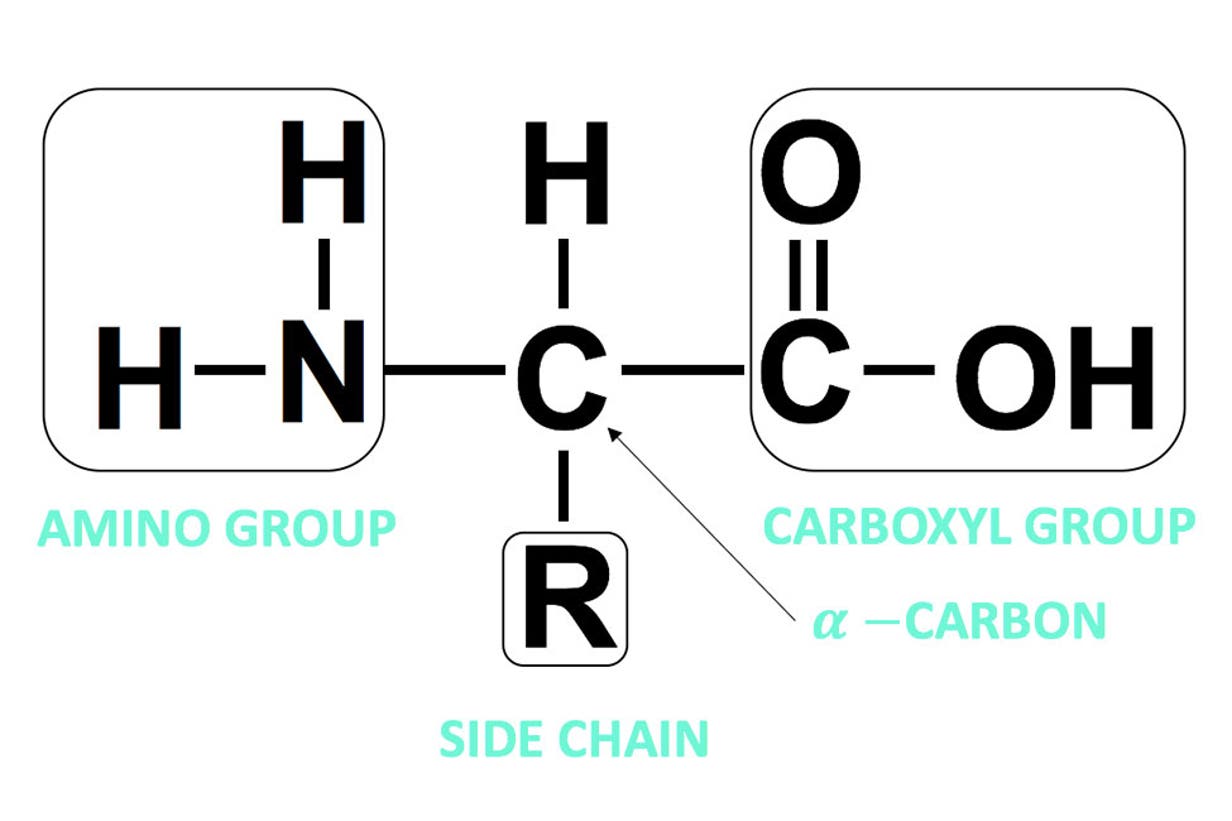Amino acids play a vital role in the human metabolism. They are not only the natural building blocks of proteins and peptides, they are also the precursors of different biological substances, like hormones and neurotransmitters. If you’re reading this thinking it all sounds a bit complicating, don’t worry. We’re about to provide you with a whole new understanding of how amino acids are structured and a deeper explanation of their function within the body.
Types of amino acids:
For the science geeks, amino acids are built from one carbon atom, to which an amino group (NH2), a carboxyl group (COOH), a hydrogen atom (H) and one amino-acid specific group (R) is bound:

There are two different types of amino acids: non-proteinogenic amino acids and proteinogenic amino acids. Non-proteinogenic amino acids exist in multiple different forms in the body and nature and have for example functions as coenzymes or toxins.
For us, the proteinogenic amino acids are of higher interest right now. Proteinogenic amino acids are the only ones, from which peptides and proteins are built. A chain with less than 100 amino acids is normally referred to as peptide, whereas proteins are constructed of more than 100 amino acids. (Side note: If we speak of amino acids from now on, we are referring to the protein-building ones).
There are only 20 “protein-building” amino acids, of which overall 8 are essential (Namely – geeks watch out: valine, leucine, isoleucin, phenylalanin, methionin, lysin, threonin and tryptophane). This means that they cannot be synthesized by the human organism and therefore have to be ingested through nutrition. Three of these essential amino acids have earned some fame in the last years: leucine, isoleucine and valine, which are also known as the “BCAAs”. BCAA is the abbreviation for “Branched Chain Amino Acids”, which is referring to their specific chemical structure. BCAAs are known for directly triggering muscle protein synthesis, as well as for keeping blood sugar levels constant. (Triggering doesn’t mean building! In order to build or repair muscles, you’ll need all of the 8 essential amino acids).
What functions do amino acids have?
Amino acids do not only function as building blocks of proteins, they are also the precursors of different biologic substances, like hormones, neurotransmitters or even the pigments of your skin. Furthermore they play an important role in glucose homeostasis, which means that they can keep your blood sugar levels constant.
Three essential amino acids worth knowing:
- Leucine, which is the most important of the three BCAAs. In order to stimulate muscle protein synthesis a certain threshold of leucine has to be hit. Foods with a high leucine content are, for example, soybeans, lentils, eggs, meat and pumpkin seeds.
- Tryptophan is the biochemical precursor of serotonin. Serotonin, is a neurotransmitter, which has a direct influence on our mood. A lack of serotonin can show up with symptoms of for example, depression, aggression or fear. Foods high in tryptophan are bananas, dark chocolate, seeds and nuts, and spinach.
- Lysin is one of the most important building blocks of collagen, which is, again, a building block of the connective tissue. A lack of lysin can thus lead to the weakness of the connective tissue. Foods high in lysing are for example fish, milk products and avocado.
Amino acids and their influence on protein quality
The term “protein quality” of a food is referring to its specific amino acid profile. Foods with a high protein quality have an amino acid profile which is closely resembling the human amino acid pattern and which can thus be easily transferred into endogenous protein. It is therefore important to combine different protein sources skilfully in order to increase the quality of a single food. Plant based and animal protein are complementing each other, but also the mixture of different plant sources can increase the protein quality strongly. Especially in sports the following rule applies: quality before quantity!
But you don’t have to panic about how to ingest all of the essential amino acids at the same time. If you are eating a source of protein with each meal, which is not the same protein source every time, you will most certainly get all the essential amino acids you need.
Let’s recap
Proteinogenic amino acids are the tiny little building blocks of proteins, which again are e.g. the building blocks of your muscles or even your hair. Overall 8 of the 20 proteinogenic amino acids are essential, which means that they can not be synthesized by the human body, but have to be ingested through nutrition. But those amino acids do not only function as building blocks of your muscles, they play also a vital role in the human metabolism as precursors of hormones or neurotransmitters.